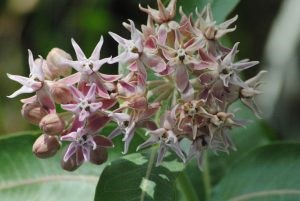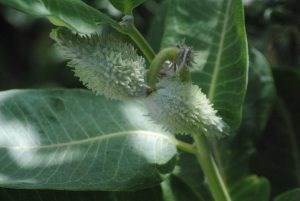This content was originally published by the Longmont Observer and is licensed under a Creative Commons license.
Milkweeds were named after Asclepius, the Greek god of healing because the latex of some species can be used medicinally. The plants contain a milky, white sap that consists of latex and several other compounds.

There are over 140 species in the milkweed family, of which, Colorado is home to nineteen. The flower structures are among the most complex in the plant kingdom. The flowers of the milkweed range in color from white, green, pink, and orange to yellow.
Milkweed colonies are often actually the same plant. The roots of milkweeds are rhizomes which branch and grow each year. Leaves are broad and somewhat oval-shaped, and are opposite each other on the stem except for where the flowers emerge. Flowers occur in what is called an umbel. Think of an umbrella and how the support ribs stem off the center pole. All the flower stalks come off one stem of the milkweed. Several of these stems with flowering umbels will come off the main plant stem.

Each umbel can have between ten and 200 flowers depending on the species and each milkweed plant has on average of 3-6 umbels.
Rather than producing individual grains of pollen like most plants, the milkweed has pollen sacs or pollinia. Each flower has five slits in it that lead to the pollinia. When an insect lands on the flower, its leg can end up in one of the slits. The pollinia attach themselves to the insect’s feet and when the insect flies off it takes a pollen sac with it. If the insect is not large enough to pull the sac free, it can become trapped on the flower and lose a limb or die.

Pollination of the milkweed occurs when one of these pollen sacs becomes trapped in the anthers, the male part, of the flower. Seeds are produced in pods known as follicles, with each one containing over 200 seeds. As they ripen, the follicles orient themselves vertically. When ripe, the follicles split open and the seeds are carried off in the wind by hairs which are known as the coma. The majority of the flowers will not produce a seed pod.
To limit the damage caused by feeding, the milkweed plant defends itself in several ways. The leaves have smalls hairs on them and the plant itself has latex fluid which contains toxins known as cardenolides. The small hairs make the leaves unpalatable to many herbivores. All life stages of the monarch butterfly ingest toxins from the milkweed and concentrate them in their bodies. This helps to protect them from predators due to the bitter taste.
The milkweed plant has some surprising uses. The filaments contained in the cotton-like coma that is attached to the seed is coated with wax and can be used as insulation material. During WWII, over 5,000 tons of milkweed filaments were collected in the United States to replace kapok in life preservers. Found in the tropics, kapok is a plant that is also used for insulation. Milkweed is grown commercially, and as of 2007, is used as a hypoallergenic filling for pillows.

The milkweed fibers are used for cleaning oil spills. Native Americans used milkweed as a sweetener because the plant has a high sugar content. As already mentioned, milkweeds can be poisonous as well, and animals eating too much of it can die as a result.
Milkweeds are an important food source not just for monarchs, but also for bees and wasps as well. Bees and wasps feed on the nectar of the flower, while the monarch butterfly larva feeds on the leaves. Beetles and moths, as well as several other bugs, also use milkweed as an important food source. Monarchs lay eggs on the milkweed leaves so that when the larvae hatch they have a ready food source. Milkweeds are the only food source used by monarch butterflies.
The populations of both monarchs and honeybees are declining. Milkweeds play a vital role in maintaining these populations. Because of this, there has been a movement to plant milkweeds in gardens. If you are interested participating, it is best to plant milkweed that is native to Colorado. The Flower Bin in Longmont sells native milkweed plants and there are online sources of milkweed seeds. Just be sure to do your research to make certain you are planting a species native to Colorado. Not only will you be helping monarchs and honeybees, but you will have beautiful, interesting flowers in your garden as well!


